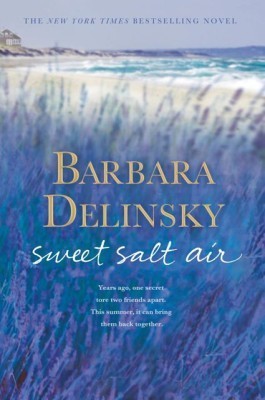Barbara Delinsky's Blog, page 8
July 23, 2014
Novel salad
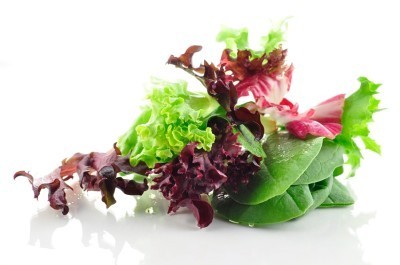
There will be six of us for dinner Saturday night, including a couple of really good cooks, meaning that if I try to compete, I fail. So what to serve? I may write good books, but a gourmet cook I am not.
My gut tells me that it’s best to go with simple and fresh, which, this time of year in the Northeast, means a big multi-ingredient salad. Fresh veggies and fruit, lettuce from the garden, sweet corn … they’re my key ingredients. Hey, don’t yawn. Salad may be healthy, but it doesn’t have to be boring.
Start with lettuce. There are different flavors, colors, and texture. My very favorite kind is butter lettuce (a.k.a. Boston Bibb), but in a big salad I’ll add red leaf lettuce, spinach, or even a little kale. Romaine seems to have an extra-long life in my fridge, so I usually have some of that around. Do I want my salad in full leaves or chopped? Depends on my mood.
Next, veggies. Peppers are always good for color and health, but I use them during the rest of the year, so sometimes in summer I steer clear. Zucchini or summer squash, blanched and diced, adds texture. Likewise, seedless cukes, either sliced or diced. And once the local crop arrives, sweet corn is the best. I cook the corn earlier in the day, remove it from the cob with a knife, and toss it in. Fresh asparagus from earlier in the week? Into the bowl. Same with whatever color tomatoes are on sale at my farm stand in a given week. How about dinner leftovers, even of frozen veggies, like peas or green beans? In they go.
If I have apple slices left in the bag I bought for my grandkids, I throw them in, too. Actually, I’ll thrown most anything from my fridge into a salad. We’re talking bacon, ham, hard-boiled-egg, or sliced chicken, any one of which, of course, adds protein to make the salad a meal in itself.
Oh oh oh, I nearly forgot cheese. Most any kind works in a salad. I always keep blocks of Cabot’s cheddar in my fridge as a source of calcium. If I’m looking to add some to my salad, I cut little strips and add them.
And nuts, can’t forget nuts. Pine nuts, walnut, pecans, pistachios — I’ll add whatever I have.
Okay. I really have given you lots of choices here, and truly? If I do want the simple and fresh I mentioned above, I’ll got for 4-5 interesting ingredients, rather than 10, which means that another day, I have 4-5 other interesting ingredients to use. Moreover, if you’ve included even half of what I’m listing above, your salad is getting up there in calories.
You may want to watch that, especially when it comes to dressing. Sometimes I make my own, especially when I’m in a Sweet Salt Air herb mood. Often, though, it’s more work than I want. And let me say right here, I detest diet dressing. Some people swear by it, but I haven’t found one that works with my taste buds in a way that doesn’t ruin the rest of the salad. My solution? Dribble. Regular. Dressing. A little salad dressing can go a long way. The dressing should be like background music during dinner – i.e., subtle and muted.
What else do you add to your salad? I ask, because I’m always looking for something new. Something novel. Pun intended.
July 7, 2014
My Maine Childhood

I’m a Maine-summer girl. Some of my earliest memories are from visiting my dad’s sister’s place on Lake Sebago or my mom’s father’s cooperage in Portland. Then my mother died, and I was sent away to camp. If that sounds cruel, listen up.
I was eight when my mother died. And back then, believe it or not, I was the only child in my school class who didn’t have two parents in the home. Cut to summer camp six months later. We’re talking eight weeks away from home, on the shores of Crystal Lake in Harrison, Maine. Suddenly, I was in a new place with non-stop activities from Reveille, blown on a real live bugle at seven in the morning, to Taps, blown at nine at night. More to the point, I was in a bunk with seven other girls, in a row of eleven other bunks, each with eight girls, none of whom had mothers there either. I was no different from anyone else.
We were all homesick. We bonded over that, I’m sure – though it could have been the hospital corners we couldn’t quite get right on our cots, or the swims on frigid mornings, or the trek to the shower house for mandatory twice-weekly showers. I don’t think of those things now, though, when I remember those summers. I think of the girls, my bunkmates and teammates, friends I desperately missed when summer ended, and some of whom I am still in touch with. And I think of the setting.
Picture grassy fields, clay tennis courts, and a pine path leading down to the lake. Smell the pines bordering that path and the fire in the main bunk hearth each morning. Taste s’mores at weekly cookouts. Hear the sound of the lake at night, lapping oh-so-gently against the shore.
Those summers were formative ones for me. I thrived there in the woods by the lake. Years later, when my husband and I were shopping for a lake place, my litmus test was whether I could close my eyes and hear that oh-so-gentle lapping of water on rocks. But Maine didn’t wait for my house. For years before we found it, we were day-tripping to the southern Maine coast and weekending in places like Boothbay and Bar Harbor, Ogunquit, Kennebunkport, and Portland.
Maine has inspired many of my books, dating back to romances like Sweet Ember, Jasmine Sorcery, and Surrender by Moonlight, and moving on to full-lengthers, like Facets, Within Reach, and For My Daughters. And now we have Sweet Salt Air and The Summer I Dared. Both are set in Maine, both newly released in my favorite trade paperback format, both the perfect summer read guaranteed to take you up and away.
These are sensual books, as in dealing with every sense we possess. As are my memories of Maine summers, they are rich in the sights and smells and tastes of Maine. They also hold a whole lot of my heart and soul. Remember that as you read them. I’ll never write a memoir, but these books come pretty close.
Do you have a special place like my Maine?
June 11, 2014
Notice any changes?
The new, gorgeous, trade paperback edition of Sweet Salt Air is now on sale! It’s the second generation, so to speak, which means it’s been improved upon. The changes are subtle. You may not notice them unless you study both editions side by side. I’m telling you about the changes here, so that you’ll know this: I listen when you speak.
When Sweet Salt Air came out in hardcover, some of you found typos. One or two of you were scathing – what kind of sloppy publishing is this? Please, believe me when I say that typos do not reflect sloppiness on my part or that of my publisher. They don’t occur from lack of reading or rereading these pages. Perhaps they happen because of that; often we have either read them so many times or are so familiar with the story that we just don’t see typos. And yes, we do have first-time, cold readers proof-reading the pages. Inevitably, though, a few typos get through. I like to joke that I’m simply keeping you all on your toes, like I deliberately plant those typos. Of course, I don’t. As you write me, though, I keep a list. The list goes to my editor in time for the paperback edition, so that this new trade paperback edition should be perfect. My thanks to those of you helped me with this!
More important to me are remarks about content. I received one note from a woman who said she loved Sweet Salt Air right up to the next-to-last page, when a character (I won’t say which one, trying to be vague enough to avoid a spoiler) remarked on how active her in utero baby was. There was a mention that if the baby was a boy, it might be a tap dancer, and, “Is that what you want for your son?” A reader took umbrage at this, saying that her son is a beautiful, very masculine ballet dancer, and that she wouldn’t have him any other way. She was absolutely right. Though I hadn’t meant any offense – I was thinking more along the line of society giving male dancers a hard time – my words could have been taken the wrong way. So I changed them. And I thank this reader for deepening my sensitivity here.
Finally, if you did buy the hardcover version of Sweet Salt Air and compare its cover with the new paperback one, you’ll see a difference at the very top, where turquoise water, beach, and a strip of sky have been added, along with a view of the house. These changes were requested by one of the major accounts ordering the book, and I heartily thank both that account and my publisher for making this change. I always loved the artwork on Sweet Salt Air, but this small alteration makes the cover brighter and even more perfect!
Oh. One more change between hardcover and paperback edition. Bonus pages. “Reading Group Gold,” my publisher calls it, and it consists of fifteen pages added at the end of the book offering (a) a conversation with me, (b) my thoughts on friendship and how they’re reflected in Sweet Salt Air, and (c) a Reading Group Guide. You don’t have to be in a reading group to use the last. I often check out reading group questions as a way of focusing my thoughts as I read a book.
When Sweet Salt Air came out in hardcover last June, it was my 21st novel to hit the New York Times list. And now, for those of you who waited patiently for the less expensive paperback edition, the wait is over. With the 2014 summer reading season starting, the timing couldn’t be better. Sweet Salt Air is the quintessential beach read. If you want a book set on a Maine island, with fabulous food, great sex, and a moral dilemma to challenge your mind just enough, this one’s for you.
And the trade paperback format? Very special. I like the feel of it in my hand; it’s nearly as solid as hardcover without quite the weight. I like the readability of the print, which is larger than that of the mass market edition. And I like that it costs nearly half what a hardcover book does.
There you go, my friends. Sweet Salt Air is now on sale in trade paperback. You’ll find a plot summary, my personal comments, sample chapters and more at www.barbaradelinsky.com. As always, I’d love to hear from you. Feel free to send me a note or post a comment (or read others’ comments) on Facebook.
A final thought. If you’ve already read Sweet Salt Air and are looking forward to my next book, it’s almost done. Once it is, I’ll start telling you about it, so please do check back. Right here.
March 26, 2014
Are you a matchmaker?
Have you ever played matchmaker and fixed up at friend? Ever been fixed up yourself, as in, agreed to a totally blind date on the say-so of someone else playing matchmaker?
Matchmaking fascinates me. No, I’ve never done it – have never known two people who are available at the same time and might actually like each other – but I do love stories of weddings from fix-ups and the pride that the matchmaker feels.
What are the risks? In theory, nothing. You try a match with the best of intentions, and if you fail, you try again. In reality, it’s more complex. The friend you’re fixing up may be fragile, which puts her self-esteem at stake. And if she thinks the guy you paired her with is a total jerk, your friendship may be hurt. We all want our friends to trust our judgment, right?
Matchmaking does sometimes work, though, hence the point of this blog. My Matchmaker Trilogy is coming in eBook form on April 1. The covers are brand new. You like?
I have always loved this trilogy – in part because Victoria Lesser is no typical matchmaker, but also because the dynamic of throwing two people together without their say-so and at horrible times in each of their lives, is great fun to write.
Half the fun, of course, is the isolated settings in which my characters find themselves. As opposed to an evening’s blind date, which, if disastrous, is over and done in a few hours, the couples in these books are stuck with each other for far longer in a place that is either isolated or remote. In other words, they can’t escape. If they hate each other (which some do), they’re stuck. Granted, hate can evolve into love given time and opportunity. Still, being ‘stuck’ harkens back to the concept of arranged marriages, which give me the willies.
Whereas all three books in the Crosslyn Rise trilogy take place in the same north-shore-of-Massachusetts setting, the three books in the Matchmaker Trilogy have scattered settings. The Real Thing is set on a remote Maine island; Crossed Hearts is set in a rural New Hampshire cabin in the woods; The Invitation is set in the Caribbean, which is where I’d like to be right now, given the nightmare of the winter we’ve had. A warning here. If you read these three books when they first came out, you may be confused, because my publisher has changed the names of two of the three. The Real Thing is still The Real Thing, but Crossed Hearts was originally Twelve Across, and The Invitation was originally A Single Rose. Each book stands on its own, though you’ll love getting updates on earlier characters if you read them in order – The Real Thing, then Crossed Hearts, then The Invitation.
The Matchmaker Trilogy is more than twenty years old, but these three books were among my later romances, hence written in a style closer to my current one. If you’ve read any of the three before, why not pay a revisit? I did and was rewarded with three thoroughly fun reads.
Please let me know what you think!
March 13, 2014
What does art do for you?
My husband and I recently visited the Peabody Essex Museum in Salem, MA, to see an exhibit of Impressionist art. I’ve always adored Impressionism, but I wasn’t prepared for what I found – and I’m not talking about the art itself, though that was breathtaking. I’m talking about my reaction to it.
I was enchanted, warmed, and enriched. I was awed by the skill of these artists. But what I loved most, truly, was being swept away to another place and time. With once glance, I was in the French countryside or on the coast. I was taking shelter from a storm or watching a regatta. I was standing in high grass in my ankle-length skirt, holding a parasol, breathing in the sweet salt air of the sea.
I had forgotten what fine art can do. I’m sure it’s different for different people. But for me, it taps into every little life experience I’d ever had that remotely relates to the subject of the painting before me. In some cases, it even captures my dreams.
Art and I go back a ways. As a child, I did paint-by-number renditions of Gainsborough’s “The Blue Boy.” I did jigsaw puzzles of Monet’s “Water Lily Pond” and Van Gogh’s “Starry Night.” I even collected little art prints – I mean, really little art prints, like 2” X 3” prints that I sent for in the mail and then mounted in a scrapbook with black corners. We used to call these minis such-and-such prints, and I’ve been trying to remember what such-and-such is, but can’t. Is this ringing a bell with anyone out there?
When I was in college, Keane “Big Eye” prints were the rage, and once I graduated and got married, my husband and I chose art that (a) we could afford (which wasn’t much) and (b) took us places we couldn’t afford to go. Even after money eased, the requirement that a piece speak to us remained. Most of the pieces currently in our home are depictions of woods or fields or brooks. These things drawn us in. They calm us. When I redid my office a few years ago, I decorated around a single piece of art – “Allen’s Skiff,” by New Hampshire artist, Peter Ferber.

This print has water, tall grasses and flowers, and a small boat that begs, Come lie in me, feel the sough of the water, see the sky. “Allen’s Skiff” is the first thing I see when I enter my office, and each and every time, it clears my mind.
Does art do special things for you? If so, what?
March 5, 2014
How many tweets make up a book?

What are people doing with their noses in smartphones all the time? The writer in me wonders this a lot. What are they reading? Texts from friends? Facebook posts? Work email? Is it possible, in this golden era of social media, that not being ‘social’ – as in, waiting in line at Starbucks without monitoring a device – is so uncomfortable for some people that they pretend to be communicating with the world to make themselves feel loved?
Well, that was pretty cynical of me. But honestly, what all is there to read on a smartphone? I get email on my phone. I get texts. I check the weather, traffic, or news. This blog was actually inspired by a recent Boston Globe columnist who wrote about his obsession with weather feeds when he was stranded in Europe waiting to fly home with bad weather here. I see how Twitter helped him, and I understand that he might have had little else to do while waiting hours in an airport but monitor runway conditions. I also understand that in times of emergency, revolution, or other tragedy, social media can play an important role. But the rest of the time? Tweeting constantly through the day? Do I seriously need to do this?
I like looking around. I like watching the people I pass. Facial expressions, physical quirks, interactions with companions – all are fodder for my writing. But what I write reflects my interest in people, which is the real reason I like looking around. I also like noting changes in my surroundings – whoa, that store just closed? I like breathing deeply and smelling the world. These kinds of things clear my head. I can’t imagine missing them.
There’s also the tiny matter of watching where you’re going so that you don’t bump into other people or a light post. The fact that nose-in-device people don’t do this all the time suggests that they aren’t deeply focused on what they’re reading.
I like to focus deeply. I want a book to envelope me. I want it to commandeer my mind, so that I think about it when I’ve finished, remember it a month later, even look at something in my life a little differently for having read it.
Does Twitter do that?
How many tweets make up a book? If a tweet is 140 characters, how many must you receive over, say, two days to make the equivalent of a 360-page book? More to the point, when the reading is done, what do you have? Sure, maybe you have a few good links, coupons, or knowledge of special deals, but can you actually find these once a gazillion more tweets have arrived? Do you need to know who of your friends is doing what in a given instant?
Seems to me that, mostly, what you end up with at the end of those two days is old news.
Call me cynical here, too. But I am a lover of books. Can you do it all – be an avid tweeter AND an avid reader and still have time for work, play, and actual face-to-face conversation? Tell me your thoughts. Do you tweet? If so, how much?
February 20, 2014
When I write about home construction
Does life imitate art? Not for me. For me, it’s the other way around. When life happens, I write about it. For instance, after my husband and I built our house, I wrote about home construction in the Crosslyn Rise Trilogy. When we began spending time in small New Hampshire towns, I wrote Lake News. When my aunt developed Alzheimer’s disease, I wrote Shades of Grace. When I felt overwhelmed by life’s demands, I wrote Escape.
And now? Now it’s back to construction, which is a major player in the book I’m currently writing because — drum roll, please — we’re redoing a bathroom in our house. As bathrooms go, this one is arguably our most important since it’s attached to the master bedroom. Up until now, it had a shower that was small and dark, a bathtub that was built into a large platform taking up a godawful amount of space, a toilet that wasted water, and lighting that was sparse. At the same time, there were three adjacent closets just begging to be combined into a single walk-in.
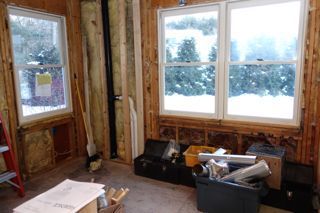
So — cymbals, please — we gutted it all, bathroom and closets. Try to imagine the mess. Imagine workers arriving at 6:30 am, hammering and drilling their way through my work day, all the while making personal use of the bathroom by my kitchen. Imagine a dumpster in the driveway, getting heavier not so much with debris from the work but with snow from this abominable winter we’ve had! Imagine a central alarm panel that had to be moved to another floor to open up one of those closets and the bellyaching of not one, not two, but three separate alarm guys who complained about the work. Imagine the framing inspector signing off on the rough framing, at the same time declaring that the window overlooking what will be a free-standing bathtub isn’t tempered glass and is therefore out of code.
Still, I’m very fortunate, and not only to be able to do this project at a time when foreclosures remain high and homelessness abounds. I get a high tech, environmentally smart, sinfully lovely bathroom out of this. Picture marble the color of streaked sand, an exhaust fan that is silent, and three separate heads in the shower-to-be pictured here.

I also get a book out of the deal. I still don’t have a title, and this new book isn’t about redoing a bathroom but about rehabbing entire houses. But the presence of a contractor, carpenters, electricians, and lumbers at my house every day doesn’t hurt. They are — trumpet flourish, here — a resource like no other, taking the edge off what might otherwise be an endlessly slow project.
How about you? Have you ever done a home improvement project? Was it a dream or a nightmare? Knowing now what you didn’t know then, would you do it again?
February 11, 2014
My Valentine’s Day Trifecta

Valentine’s Day is my kind of day. I was a romantic before I ever wrote a single romance, and once I did that – and discovered that people loved reading what I wrote – there was no end to my hearts-and-flowers imagination. All told, I wrote fifty romances, sometimes eight a year, I was that into it. But being a romance writer wasn’t, in fact, entirely hearts and flowers. There were friends who politely told me that they didn’t read “that kind of book.” Worse, there was the family member who actually told me she didn’t read “that kind of trash.” There were booksellers who hid me in a back corner when I came for a signing, rather than up front, where other visiting authors sat. And then there were people (male, usually, like the one selling me my first computer) who blithely said, “So now all you have to do is cut-and-paste different names, and you have a new book.”
People like this are ignorant. They’re also hypocrites, if the attention they give to Valentine’s Day means anything. Valentine’s Day is a huge commercial event, a day when even the emotionally squeamish are allowed to indulge in red roses and chocolate kisses. How appropriate it is, then, that the first of my two romance trilogies has just debuted in e-book form!
Trilogies are commonplace now, but when I wrote these in the early ‘90s they were not. I was at a stage in my career when the 200-page restriction of the romance genre was starting to chafe. Three books would give me a whopping 600 pages in which to tell my story. I had no problem with that story being divided into thirds.
So I conceived of a seaside book involving a gorgeous old Colonial home on a hill that its owner could no longer support, expansive acreage that included a pine grove, meadow, and duck pond, and a conglomerate willing to build homes, condos, and harbor shops in the tasteful way the owner wanted. Picture together (in Valentine’s Day mode) that owner and an architect with a tie to the land, the builder and interior designer for the project, and its realtor and a fellow-consortium member whose bookstore will be one of the first of the harbor shops.
There you have it – the Crosslyn Rise Trilogy — three separate stories woven around a single breathtaking piece of property. Each book stands on its own, but if you read them in the order in which they were written, i.e., The Dream, The Dream Unfolds, and The Dream Comes True, you’ll more satisfyingly follow the progress of the project and the characters.
Rereading the trilogy in advance of this reissue, I was intrigued. These books were among the last of my romances and, in that, are more sophisticated in style than their forebears. Hence, they are my Valentine’s Day gift to you all. They also embody my love of romance. Let’s face it – the real world can be brutally painful, and much as we want it to, hope doesn’t always win out. In a romance, it does! These books capture a fantasy, much as red roses and chocolate kisses do.
So, on or around Valentine’s Day, here’s to strong – strong heroines, heroes strong enough to bend, and a strong happily ever after.
Oh oh oh. I did mention having written two trilogies. The second, the Matchmaker Trilogy, will make its e-book-debut on April 1. I kid you not!
January 15, 2014
Do you do crossword puzzles?
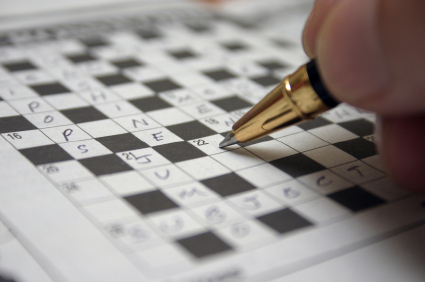
When I was a child, I saw my father come home from work every night, sit down with the newspaper, and do the crossword. I have grown up to be very different from him, but here is one thing on which we agree. Crossword puzzles are the ultimate form of relaxation for someone who enjoys playing with words. My dad was a corporate lawyer, and legalese notwithstanding, his choice of words was crucial in protecting his clients. Writing fiction, as I do, is light years removed from writing a corporate contract. Though none of you will sue me if you feel that a word or phrase or sentence I use is misleading, when I’m writing a book, I struggle with words twelve hours a day to get the nuance just right.
So why would I ever want to deal with words in my free time? Lot of reasons.
But first, a little history – and I confess that I would not have known any of this had it not been for a recent Boston Globe piece marking the crossword’s 100th birthday. That first one was created in 1913 by a British-born journalist for publication in a New York paper, and it was a total hit. Despite doubters who anticipated a passing fad, the cross word puzzle’s popularity burgeoned. Across the country, across the world, newspapers began running crossword puzzles as regular features.
What’s the appeal? I can’t speak for the estimated 50 million puzzle solvers in America alone, but here are my own reasons.
It’s fun. There’s no violence, no gore, no intrigue that might keep me from falling asleep à la, say, “Homeland.”
It’s distracting. Try coming up with different meanings for a word or phrase, and I forget my guilt over eating those mashed potatoes with dinner.
It’s a private challenge. The world never knows whether I get everything right, guess the overall clue, or even finish.
It’s an inspiration. I see a word I haven’t thought of in years, and it becomes a new best friend. I may even use it in a book.
Not all crosswords are equal. If you’re a regular solver, you’ll have tried different sources and know what I mean. A puzzle that’s too easy is no more fun than one that’s impossible to solve. My personal favorite appears in the Wall Street Journal every Friday. Second to that comes the Sunday Boston Globe puzzle.
I spend a week on a single puzzle. My first try is usually vague. Other than a handful of answers, I may be largely stumped. My second try is usually better. By the third approach, I start seeing clues in a different light. Funny, how words or phrases can have such different meanings. Likewise, how a single letter in a word can be a giveaway.
My father always did his crosswords in ink. So do I. Call that arrogant, but it’s more a product of caution. I rarely fill in a word until I have one of the intersecting words as well, which means that the odds of both answers being correct are higher.
I have loved crossword puzzles for so long that I actually created one for my book Twelve Across, whose heroine writes them for a living. Let me tell you, it is not easy. I have the utmost respect for those who create crossword puzzles on a regular basis.
So. Do you do crosswords? If so, what’s your favorite source? And what’s the major appeal of the puzzler for you?
December 25, 2013
What’s coming for Barbara in 2014
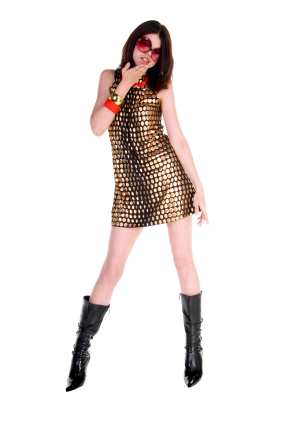 As 2013 fades to 2014, it’s only natural to think about ending the old and beginning the new. But is that what really happens?
As 2013 fades to 2014, it’s only natural to think about ending the old and beginning the new. But is that what really happens?
Not in my book. And I mean that both literally and figuratively. I don’t see that we end and begin. Life is a continuum. What we do today is colored by what we did yesterday. We appreciate what’s in front of us all the more for what’s behind. We are the sum of our parts.
Which brings me to the newest Barbara Delinsky book, my work-in-progress.
I’ve written the first half and will be heading down the home stretch as soon as the bubbly from New Year’s Eve goes flat. I don’t have a title for it yet. Well, actually, I have about twenty titles but can’t pick one, in part because I really really really like several and in part because my publisher may hate them all. If so, they’ll come up with one we both like, and I’m good with that. A title is a marketing tool. I write the book, they market it.
So what’s the book about? Here’s the opening of the proposal I gave my publisher.
A daughter’s chance at happiness might cost her mother everything…
Jamie MacAfee is ambitious – but being pitted against her own mother for a job they both want? She hadn’t planned on that, any more than she’d planned on instant parenthood and an upended love life. As her tidy world comes apart, she needs her mother more than ever. But will Caroline be there for her if Jamie steals her dream?
Let me say, right off the bat, that my heart of hearts is with Jamie’s mother. I adore Caroline MacAfee. Having overcome a marriage that destroyed her self-esteem, she has rebuilt herself into a strong, smart, successful woman. She is now fifty-six, not at all old by modern standards. But it is old in a field that prizes a flawless face. So Caroline is told that her daughter will be replacing her in the job she adores.
How would you feel if you were Caroline? Or if Caroline were your mother?
This book is about old and new, age and beauty, classic and novel. One of several backdrops to the story is home construction, as in renovating old houses and building new ones. Caroline lives in a charming Victorian that exudes history, while Jamie’s condo is sleek, white, and new. See where I’m headed?
Want to help? I’m making a list of things in life that age well. Wine is one example. Others can be wood, leather, music, books. What can you add to the list?
BTW, my favorites among those twenty titles are Home Plans, Ageless, What Matters More, and What We Build. What do you think?
I’ll finish this book by June, and it will be published as your summer escape in 2015. I post sneak previews from time to time, so do check back here. In the meanwhile, please know that I wish you a 2014 that is filled with warmth, happiness, and peace.

